From the U.S. Postal Service announcement on October 22, 2019: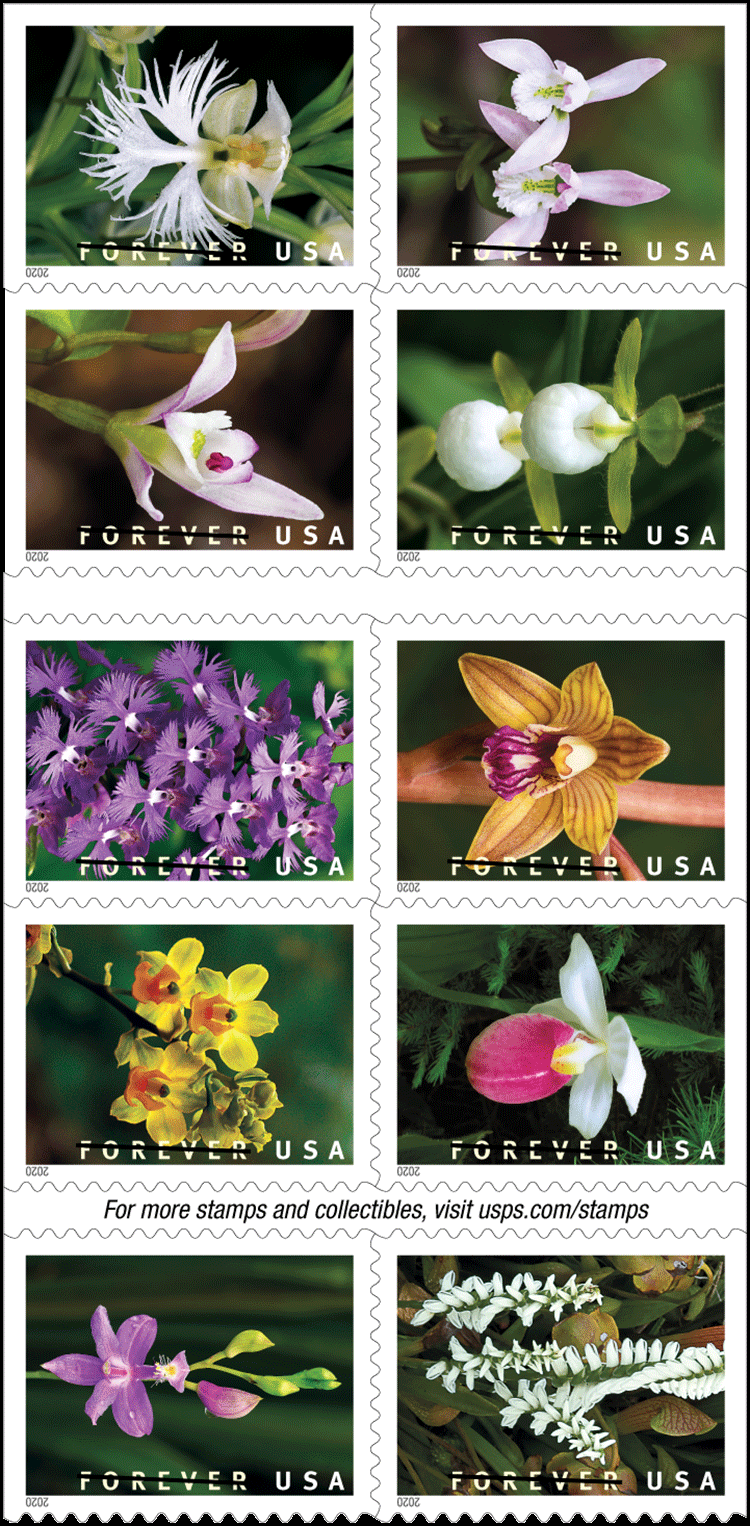
The Postal Service celebrates the exotic beauty of orchids with 10 new stamps in booklets of 20 and coils of 3,000 and 10,000. Each stamp features a photograph of one of nine species that grow wild in the United States: Cypripedium californicum, Hexalectris spicata, Cypripedium reginae, Spiranthes odorata, Triphora trianthophoros, Platanthera grandiflora, Cyrtopodium polyphyllum, Calopogon tuberosus and Platanthera leucophaea. Orchids also have common names, with some plants having several different names in popular use. Art director Ethel Kessler designed the stamps with existing photographs by Jim Fowler.
Additional information will be posted below the line, with the most recent at the top.
Updated April 4th:
The Scott catalogue numbers for this issue are:
Coil version:
5435 Platanthera grandiflora, serpentine die cut 10¾ vert.
5436 Cyrtopodium polyphyllum, serpentine die cut 10¾ vert.
5437 Calopogon tuberosus, serpentine die cut 10¾ vert.
5438 Spiranthes odorata, serpentine die cut 10¾ vert.
5439 Triphora trianthophorus (two flowers), serpentine die cut 10¾ vert.
5440 Cypripedium californicum, serpentine die cut 10¾ vert.
5441 Hexalectris spicata, serpentine die cut 10¾ vert.
5442 Cypripedium reginae, serpentine die cut 10¾ vert.
5443 Platanthera leucophaea, serpentine die cut 10¾ vert.
5444 Triphora trianthophorus (one flower), serpentine die cut 10¾ vert.
a. Horiz. strip of 10, #5435-5444
Booklet version:
5445 Triphora trianthophorus (two flowers), serpentine die cut 10¾x11 on 2 or 3 sides
5446 Cypripedium californiacum, serpentine die cut 10¾x11 on 2 or 3 sides
5447 Hexalectris spicata, serpentine die cut 10¾x11 on 2 or 3 sides
5448 Cypripedium reginae, serpentine die cut 10¾x11 on 2 or 3 sides
5449 Spiranthes odorata, serpentine die cut 10¾x11 on 2 or 3 sides
5450 Platanthera leucophaea, serpentine die cut 10¾x11 on 2 or 3 sides
5451 Triphora trianthophorus (one flower), serpentine die cut 10¾x11 on 2 or 3 sides
5452 Platanthera grandiflora, serpentine die cut 10¾x11 on 2 or 3 sides
5453 Cyrtopodium polyphyllum, serpentine die cut 10¾x11 on 2 or 3 sides
5454 Calopogon tuberosus, serpentine die cut 10¾x11 on 2 or 3 sides
a. Block of 10, #5445-5454
b. Convertible booklet pane of 20, 2 each #5445-5454
Updated March 2nd:  VSC member Mike DePaz at the first day ceremony.
VSC member Mike DePaz at the first day ceremony. 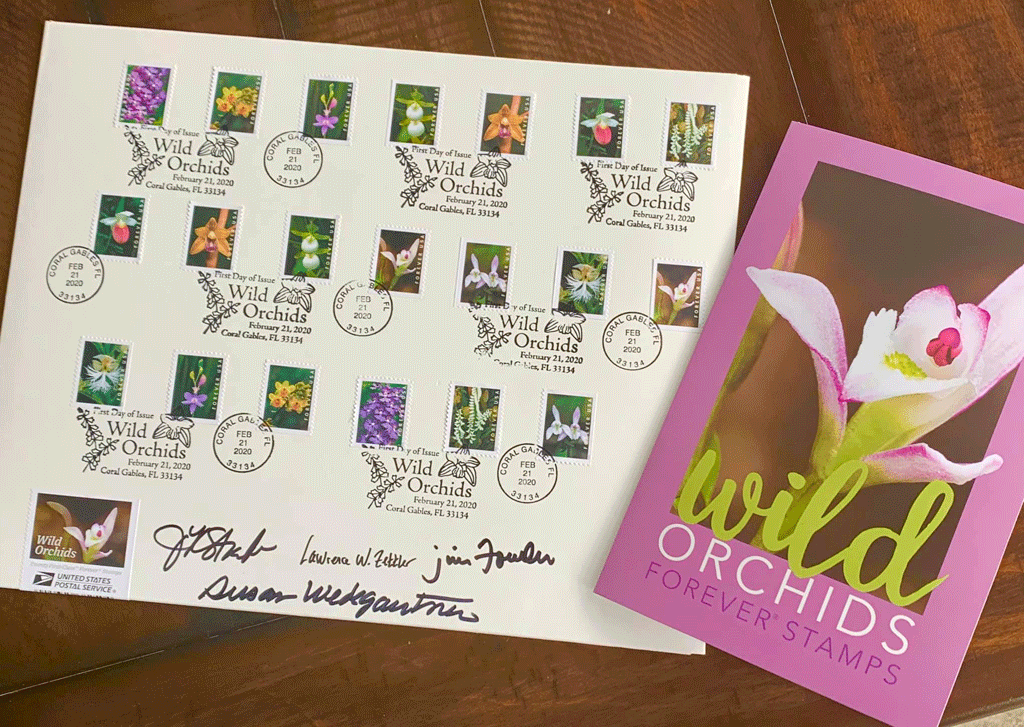 A large cover created by DePaz containing all the stamps in both the booklet and coil formats, with autographs of ceremony participants, plus the first-day ceremony program.
A large cover created by DePaz containing all the stamps in both the booklet and coil formats, with autographs of ceremony participants, plus the first-day ceremony program. 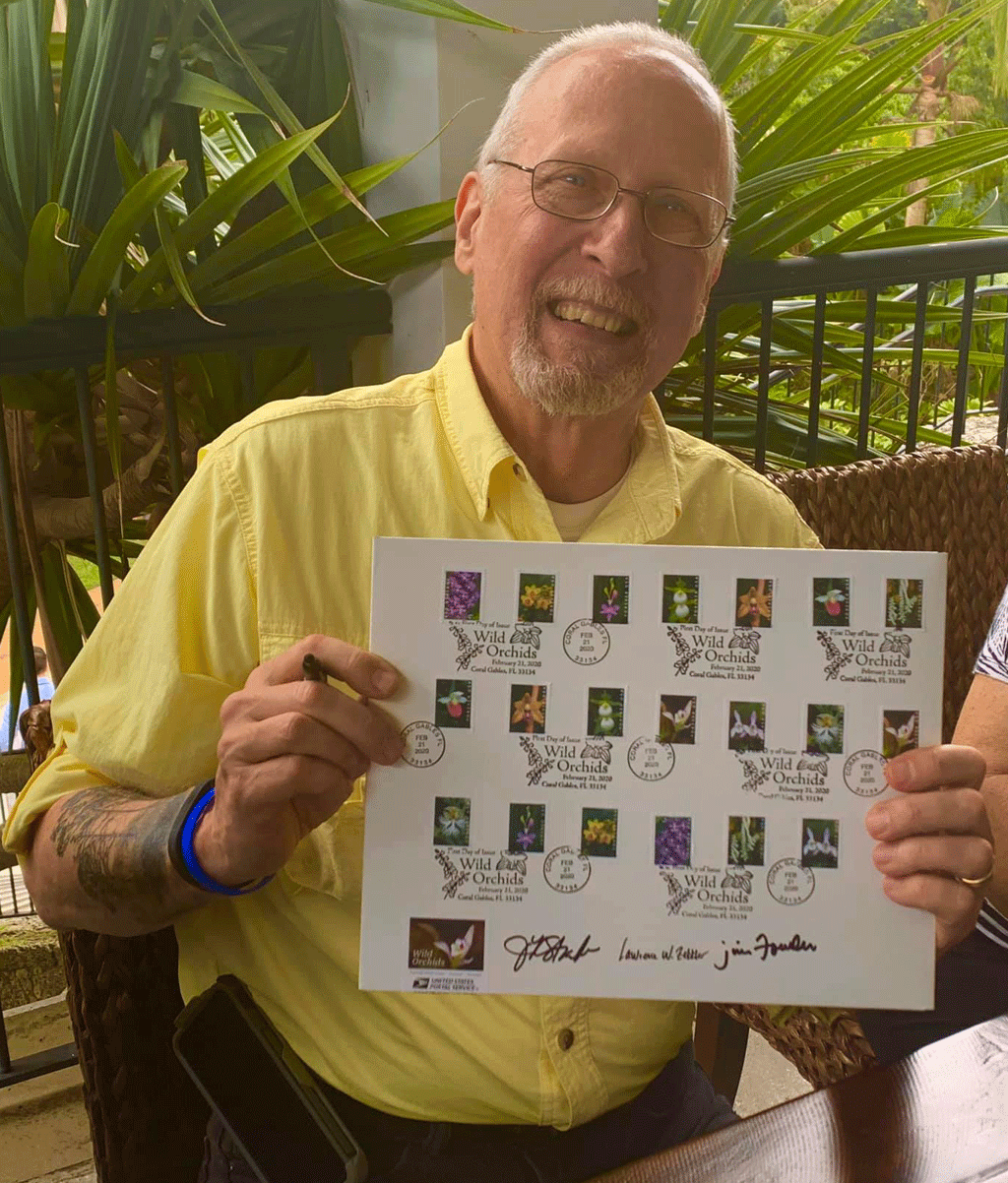 Jim Fowler, the photographer of the images used on the stamps, holds DePaz’s jumbo FDC.
Jim Fowler, the photographer of the images used on the stamps, holds DePaz’s jumbo FDC.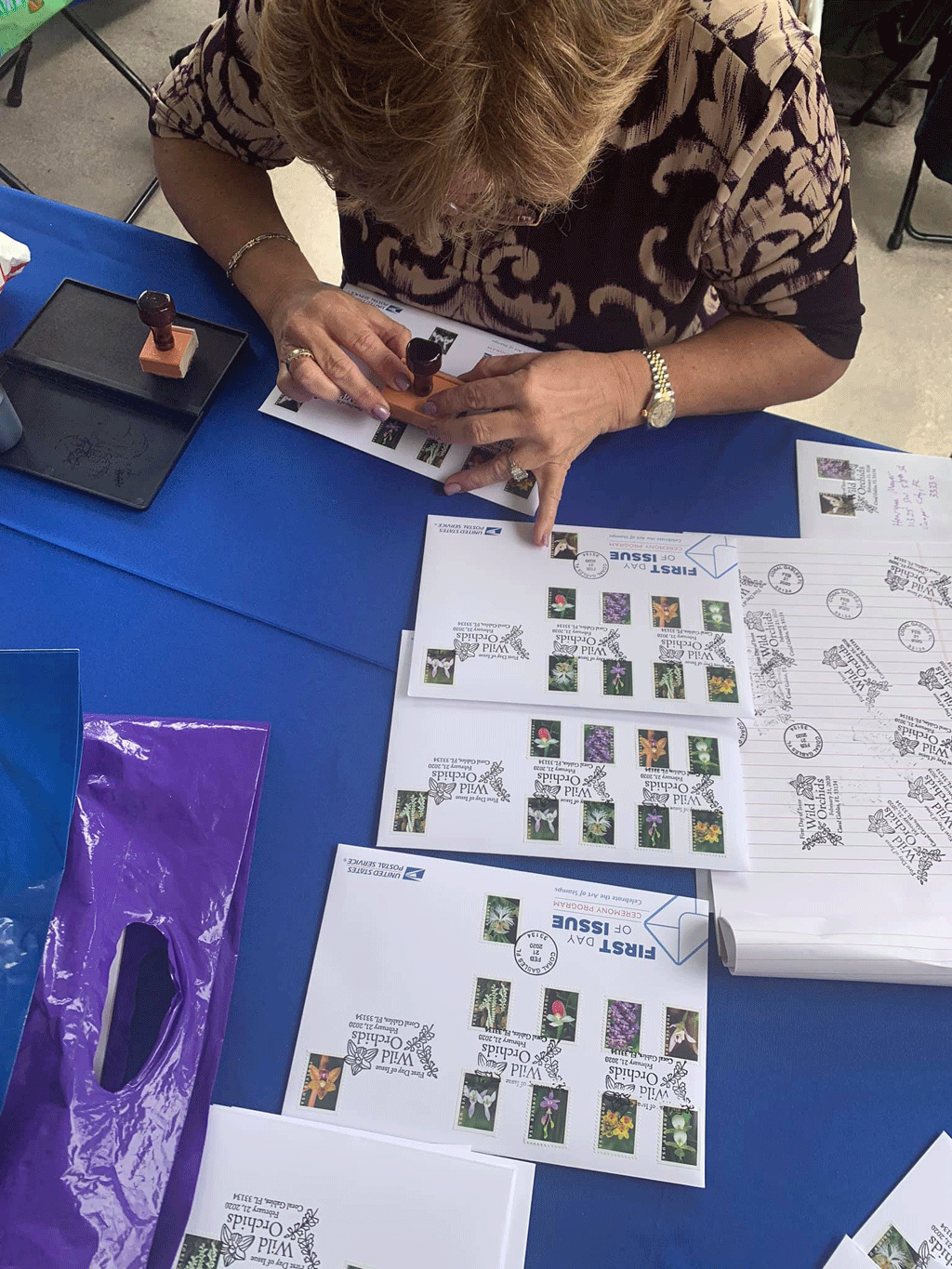 Someone canceling covers at the ceremony site. Photographs courtesy Mike DePaz.
Someone canceling covers at the ceremony site. Photographs courtesy Mike DePaz.
Updated January 21st: Here are the first-day postmarks for this issue: 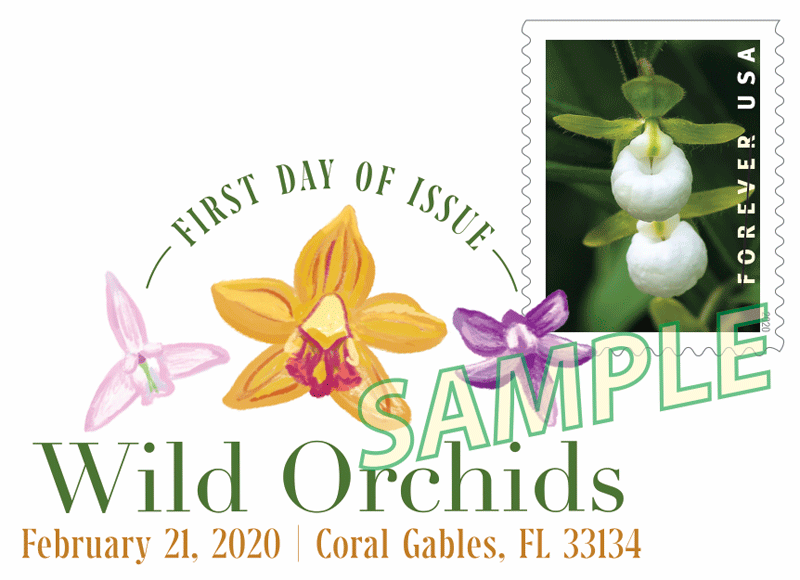 The Digital Color Postmark measures 2.38″ x 1.46″
The Digital Color Postmark measures 2.38″ x 1.46″ 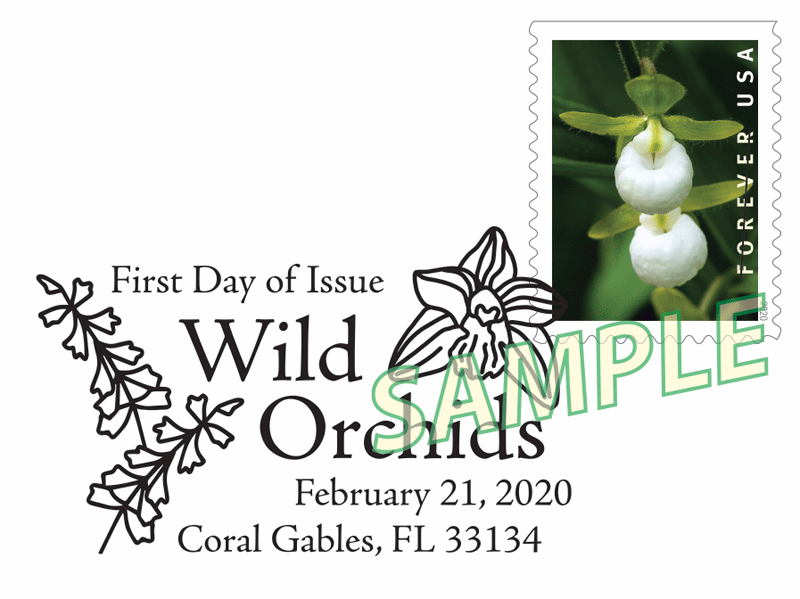 The B&W pictorial postmark measures 2.0″ x 1.23″
The B&W pictorial postmark measures 2.0″ x 1.23″
Updated January 16th:
Note that USPS is selling smaller quantities of the coil varieties of this stamp, through its mail/phone/internet sales:
Coil of 10,000:
760715 Strip of 500, $275.00
760703 Strip of 25 with plate no., $13.75
760716 First-Day Covers (set of 10, $9.90
Coil of 3,000:
750415 Strip of 500, $275.00
750403 Strip of 25 with plate no., $13.75
From the Postal Bulletin:
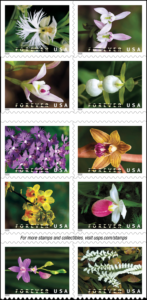 On February 21, 2020, in Coral Gables, FL, the U.S. Postal Service® will issue Wild Orchids stamps (Forever® priced at the First-Class Mail® rate) in 10 designs, in a pressure-sensitive adhesive (PSA) booklet of 20 stamps (Item 682500), a PSA Coil of 3,000 stamps (Item 750400), and a PSA Coil of 10,000 stamps (Item 760700). The stamps will go on sale nationwide February 21, 2020, and must not be sold or canceled before the first-day-of-issue.
On February 21, 2020, in Coral Gables, FL, the U.S. Postal Service® will issue Wild Orchids stamps (Forever® priced at the First-Class Mail® rate) in 10 designs, in a pressure-sensitive adhesive (PSA) booklet of 20 stamps (Item 682500), a PSA Coil of 3,000 stamps (Item 750400), and a PSA Coil of 10,000 stamps (Item 760700). The stamps will go on sale nationwide February 21, 2020, and must not be sold or canceled before the first-day-of-issue.
The Postal Service celebrates the exotic beauty of orchids with 10 new stamps in booklets of 20, and coils of 3,000 and 10,000. Each stamp features a photograph of one of these nine species that grows wild in the United States:
- Cypripedium californicum,
- Hexalectris spicata,
- Cypripedium reginae,
- Spiranthes odorata,
- Triphora trianthophoros,
- Platanthera grandiflora,
- Cyrtopodium polyphyllum,
- Calopogon tuberosus, and
- Platanthera leucophaea.
Orchids also have common names, with some plants having several different names in popular use. Art director Ethel Kessler designed the stamps with existing photographs taken by Jim Fowler.
No automatic distribution to post offices of any of the three formats:
- Item 682500, PSA Double-sided Booklet of 20 Stamps
- Item 750400, PSA Coil of 3,000 Stamps
- Item 760700, PSA Coil of 10,000 Stamps
How to Order the First-Day-of-Issue Postmark:
Customers have 120 days to obtain the first-day-of-issue postmark by mail. They may purchase new stamps at their local Post Office™ or at The Postal Store® website at usps.com/shop. They must affix the stamps to envelopes of their choice, address the envelopes (to themselves or others), and place them in a larger envelope addressed to:
FDOI – Wild Orchids Stamps
USPS Stamp Fulfillment Services
8300 NE Underground Drive, Suite 300
Kansas City, MO 64144-9900
After applying the first-day-of-issue postmark, the Postal Service™ will return the envelopes through the mail. There is no charge for the postmark up to a quantity of 50. There is a 5-cent charge for each additional postmark over 50. All orders must be postmarked by June 21, 2020.
Technical Specifications – booklet pane:
Issue: Wild Orchids Stamps
 Item Number: 682500
Item Number: 682500
Denomination & Type of Issue: First-Class Mail Forever
Format: Double-sided Booklet of 20 (10 designs)
Series: N/A
Issue Date & City: February 21, 2020, Coral Gables, FL 33134
Art Director: Ethel Kessler, Bethesda, MD
Designer: Ethel Kessler, Bethesda, MD
Typographer: Ethel Kessler, Bethesda, MD
Existing Photos: Jim Fowler, Greenville, SC
Modeler: Sandra Lane/Michelle Finn
Manufacturing Process: Offset
Printer: Banknote Corporation of America
Press Type: Alprinta 74
Stamps per Booklet: 20
Print Quantity: 500,000,000 stamps
Paper Type: Phosphor Tagged Paper, Block
Adhesive Type: Pressure-sensitive
Processed at: Banknote Corporation of America
Stamp Orientation: Vertical
Image Area (w x h): 1.05 x 0.77 in./26.67 x 19.558 mm
Stamp Size (w x h): 1.19 x 0.91 in./30.226 x 23.114 mm
Full Booklet Size (w x h): 2.375 x 5.743 in./60.325 x 145.872 mm
Colors: Cyan, Magenta, Yellow, Black
Plate Size: 800 stamps per revolution
Plate Numbers: “B” followed by four (4) single digits
Marginal Markings: Header: WILD ORCHIDS Twenty First-Class Forever Stamps • ©2019 USPS in peel strip area • Barcode • Promo-tional text in peel strip area • Plate number in peel strip area
Technical Specifications – coil of 3,000:
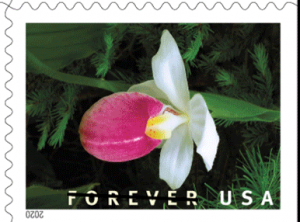 Issue: Wild Orchids Stamps
Issue: Wild Orchids Stamps
Item Number: 750400
Denomination & Type of Issue: First-Class Mail Forever
Format: Coil of 3,000 (10 designs)
Series: N/A
Issue Date & City: February 21, 2020, Coral Gables, FL 33134
Art Director: Ethel Kessler, Bethesda, MD
Designer: Ethel Kessler, Bethesda, MD
Typographer: Ethel Kessler, Bethesda, MD
Existing Photos: Jim Fowler, Greenville, SC
Modeler: Sandra Lane/Michelle Finn
Manufacturing Process: Offset
Printer: Banknote Corporation of America
Press Type: Alprinta 74
Stamps per Coil: 3,000
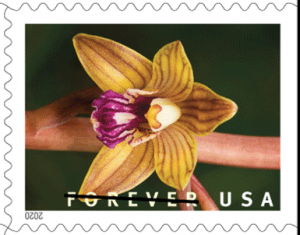 Print Quantity: 15,000,000 stamps
Print Quantity: 15,000,000 stamps
Paper Type: Nonphosphored Type III
Adhesive Type: Pressure-sensitive
Processed at: Banknote Corporation of America
Stamp Orientation: Vertical
Image Area (w x h): 0.73 x 0.84 in/18.542 x 21.336 mm
Stamp Size (w x h): 0.87 x 0.98 in/22.098 x 24.892 mm
Colors: Cyan, Magenta, Yellow, Black
Plate Size: 540 stamps per revolution
Plate Numbers: “B” followed by four (4) single digits
Coil Number Frequency: Plate number every 27th stamp
Technical Specifications – coil of 10,000:
Issue: Wild Orchids Stamps
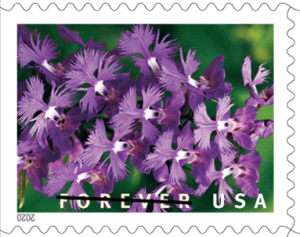 Item Number: 760700
Item Number: 760700
Denomination & Type of Issue: First-Class Mail Forever
Format: Coil of 10,000 (10 designs)
Series: N/A
Issue Date & City: February 21, 2020, Coral Gables, FL 33134
Art Director: Ethel Kessler, Bethesda, MD
Designer: Ethel Kessler, Bethesda, MD
Typographer: Ethel Kessler, Bethesda, MD
Existing Photos: Jim Fowler, Greenville, SC
Modeler: Sandra Lane/Michelle Finn
Manufacturing Process: Offset
Printer: Banknote Corporation of America
Press Type: Alprinta 74
Stamps per Coil: 10,000
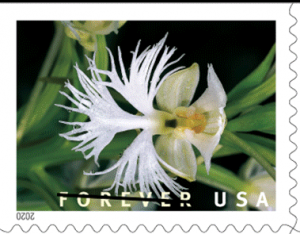 Print Quantity: 50,000,000 stamps
Print Quantity: 50,000,000 stamps
Paper Type: Nonphosphored Type III
Adhesive Type: Pressure-sensitive
Processed at: Banknote Corporation of America
Stamp Orientation: Vertical
Image Area (w x h): 0.73 x 0.84 in/18.542 x 21.336 mm
Stamp Size (w x h): 0.87 x 0.98 in/22.098 x 24.892 mm
Colors: Cyan, Magenta, Yellow, Black
Plate Size: 540 stamps per revolution
Plate Numbers: “B” followed by four (4) single digits
Coil Number Frequency: Plate number every 27th stamp
Updated December 18th: Note that the American Orchid Society has its headquarters in the first-day city, Coral Gables, FL. Nothing about the ceremony, however, is on the group’s website yet.
Updated December 10th: “With 200 species of orchids, why did they choose to use one variety twice? Makes no sense!” asked VSC member Mary.
Replied the USPS, “This booklet was simply intended as a “pretty” booklet for mail use with stamps that represent a visually diverse array of just a few of the orchids native to North America. It was not intended to be comprehensive or inclusive of as many species as possible.”
Updated November 1st: “The image is correct. These are vertically oriented stamps with the Forever USA running vertically up the side of the image. If turned so that the Forever USA reads horizontally the flowers would be lying on their side,” a USPS spokesman tells The Virtual Stamp Club.
Updated October 30th: “The Triphora trianthophoros is shown in two different images on the Wild Orchids stamps,” a USPS spokesman tells The Virtual Stamp Club.
Updated October 30th: These stamps will be issued Friday, February 21st, in Coral Gables, Florida.
Also, regarding why one species was repeated, the USPS replies: “This booklet was simply intended as a “pretty” booklet for mail use with stamps that represent a visually diverse array of just a few of the orchids native to North America. It was not intended to be comprehensive or inclusive of as many species as possible.”




Am I missing something? There are 9 names provided, but 10 stamps. Is one of the flowers a duplicate flower? They all look different to me.
I realize it says 9 species … what ones are the same? I wish it had the names of the flowers on the stamps.
“The Triphora trianthophoros is shown in two different images on the Wild Orchids stamps,” a USPS spokesman tells The Virtual Stamp Club.
Can you ask them: “with 200 species of orchids, why did they choose to use one variety twice? Makes no sense!”
From the USPS: “This booklet was simply intended as a “pretty” booklet for mail use with stamps that represent a visually diverse array of just a few of the orchids native to North America. It was not intended to be comprehensive or inclusive of as many species as possible.”
Is it normal for the small date to be inverted?
No. However, these stamp design images are always distributed as “tentative,” so the orientation of the dates might be changed in actual production. I’ll inquire.
The date should be in the same place for all the 2020 issues.
Also, thank you for finding out about the orchids, Lloyd! Much appreciated as well as the email, you’re the best.
From the USPS in reply to VSC’s inquiry: “The image is correct. These are vertically oriented stamps with the Forever USA running vertically up the side of the image. If turned so that the Forever USA reads horizontally the flowers would be laying on their side.”
The date 2020 will be aligned on the lower-right side, with the ‘2’ at the top, and the Forever USA reading Up the right side of the stamp, if the image of the flower is seen as the author intended.
If you look at the stamps with the FOREVER USA across the bottom, then you have an “Inverted Jenny” of the 2020 at the lower-left corner. The images Lloyd has are real close to the items I purchased. The B1111 and (C)2019 USPS live up with the FOREVER USA on the stamps.
( No Such Luck of another Inverted stamp. The closest recent stamp printed in reverse was the Grand Canyon stamp with the sun Setting in the East… The USPS did NOT recall these stamps.)
From USPS Newsroom 10 DEC: Issued in Coral Gables FL on 21 FEB. In conjunction with ?
And Once again, with PNC’s every 27 stamps ( Postal Bulletin 16 JAN 2020 page 45 ) why would they sell strips of 25, including the plate number? (760703, 750403) 2 stamps get sent to the recycle bucket ? Oh well, they printed 5K Coils of each size ( 3K and 10K ).
40 years ago, I went to the big philatelic window at USPS headquarters in Washington to buy a ZIP block of the $5 railroad lantern. The clerk pulled out pads of plate and zip blocks, with the adjoining stamps sliced in half. That is, the 5 adjacent stamps, $25 face value, were ruined. I gasped and the clerk replied, “It costs them a fraction of a cent to print each stamp, whatever the face value.” The same is still true, even with a 55-cent stamp. The USPS sells you 25 stamps for $13.75 and throws out two stamps with a face value of $1.10 cents… but probably spent 2 cents to print all 27. You won’t use at least $1.65 worth (3 stamps) for postage. That’s a profit.
I know. I tried to get 6 sets of a strip of 10 plus 10 singles out of the strip of 25. Guess what. I got one strip of a complete set of10 or 1 set of 10 individual singles and a whole lot of extras to use for postage from each strip! Now that’s a rip off.
Once Again, you might write to Maurice Bessette – Postmaster 1104 Plainfield Pike ONECO CT 06373. He sells Plate Strips OF ANY LENGTH to collectors, At Face, No S/H Fees. No Internet page, Does Not accept Plastic Money. Mail-in orders, Check/M.O. You get a SASE for your next order, and can be placed on his FREE mailing list.
I can’t find anywhere on the USPS website where to order the strip of 25, but it’s present on their Philatelic catalog. Can anyone help me with this??
Updated January 16th:
Note that USPS is selling smaller quantities of the coil varieties of this stamp, through its mail/phone/ ?internet? sales:
Coil of 10,000:
760715 Strip of 500, $275.00
760703 Strip of 25 with plate no., $13.75
760716 First-Day Covers (set of 10, $9.90
Coil of 3,000:
750415 Strip of 500, $275.00
750403 Strip of 25 with plate no., $13.75
It seems they haven’t gotten a Round-Tuit for this yet.
USPS.COM always seems to be a few days behind. You can order on (800)STA-MP24 voice if you want to.
Don’t feel to bad, it took Canada Post about a week to get their “year of the rat” stamp quantities out of the “Not in Stock/Sold Out”
status so people could buy them online…
Was any aware that you can only get one set of 10 stamps from a 25 stamp coil.
Why? Is it not one continuous strip of 25? Or do they send you 12 and 13?
I have both a complaint and a question. I ordered 3 strips of 20 of the coil issue of this stamp thinking I could get 6 sets of 10 for my grandchildren’s collections. It seems that the strips from the coils of 3000 contain only one each of the stamp with the yellow flowers (Platanthera grandiflora, i think) and one each of the stamp with the purple flowers and buds on a stem (Calopogon tuberosus, i think). If you save both the strip of 10 and one each of the individual stamps that makes for one heck of a lot of strips to come up with six sets of strips and singles. Now the question. Do the strips from coils of 10,000 have the same issue? I just ordered 2 of this so I guess I’ll find out.
How do you know where the plate number should be located for a plate strip if you collect plate strips? Is is always in the middle like #5 or #6 in the series or is it wherever it falls if the left hand stamp has the lowest Scott #?
I did not see the first-day ceremony program for sale on the U.S.P.S. Philatelic website. I was certain I had seen programs for sell with other issues in the past. I see the other Orchid products, but not a program for sell. Am I looking in the wrong area of the site?
I will check, but it may have been pulled off sale because there wasn’t actually a ceremony.
I stumbled on this looking for an explanation, if possible, as to how the printer can print the plate every 27th stamp on the same image if there are 10 images – since the multple is 30 stamps there would be a different image every 27th (my strips of 40 I got from MAURICE in ONECO have a single plate and roughly 2 strips plain – but all images are in order)
From Linns APR 20 Scott Coil 5435-44 Booklet 5445-54
I have used the Scott Numbers 5435-5444 to denote those coils from the 10,000 coil run in my inventory program.
To denote those from the 3,000 coil run I have used subnumbers, ie., 5435_1, 5436_1, 5437_1, and so on
Of course, I had to use the same images for stamp identification in the inventory system
Vincent, Are there any distinguishable (visible or measurable) differences between the two rolls? Such as location of micro printing (if any) or perforations?
I hope there’s a botanist or orchid expert who could identify each stamp for us. I just don’t see the pattern for the Scott booklet numbers. It doesn’t seem to be up and down or zig-zag. The date positioning confuses things even more.
The Scott U.S. Specialized Catalogue identifies the orchid on each stamp. That information, with illustrations, was included in the April 20th issue of Linn’s Stamp News. We gave the individual Scott numbers in our April 2020 update, but did not pair them with the illustrations.
You may be able to borrow the Linn’s issue from a friend or philatelic library. For copyright reasons, I can’t reproduce it here.
This may or may not help: In explaining the challenges of assigning numbers, the Scott editors said, in part, “The order of the stamps in the block of 10 found on the side containing 12 stamps in the double-sided pane differ from the order in the strip of 10 different coil stamps.” (The complete article can be found here.)
I reflexively ordered the strips of 25 for both the 3k and the 10k roll not realizing they were essentially the same stamps. However, upon inspection, I see that there is an anomaly in the 10k roll. The strip for the 3k roll contains two and half sets with all the stamps in the same sequence. The strip for the 10k roll matches the 3k roll for the first 11 stamps and the last 4 stamps (right to left), but the sequence is scrambled for the 10 stamps in between. I’m curious how that could have happened and if it is consistent for the whole 10k roll – any ideas?
I have an image for this, but don’t see how to to post it here…
The image has to be “hosted” somewhere online to be included in a message here. If you don’t have a way to do that, please send it to me at lloyd@virtualstampclub.com and I’ll post it in a reply here.
OK, if I’m doing this right, here’s the picture:
Thanks Lloyd!